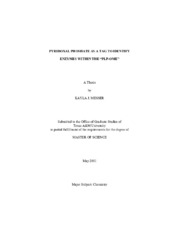| dc.description.abstract | The main objective of this research was to develop a protocol in which pyridoxal phosphate (PLP) would act as a tag to identify PLP-dependent enzymes from complex mixtures or cell lysates. Following the purification of a PLP-dependent enzyme (CysM), a method was developed to reduce the PLP-lysine Schiff base to form a chemically stable bond between the PLP and the protein. The reduced protein was enzymatically digested resulting in multiple peptide fragments with one or more containing PLP (bound to the active site lysine). These fragments were analyzed by monitoring the absorbance or fluorescence using High Performance Liquid Chromatography. Immobilized Metal Ion Affinity Chromatography (IMAC) was then used to enrich the PLP-peptide(s) from the peptide mixture. The PLP-bound peptide(s) was then analyzed using Liquid Chromatography-Mass Spectrometry (LC-MS).
More specifically, sodium borohydride (NaBH4) was used to reduce the Lysine-PLP bond in CysM. This reaction was monitored by either UV-vis spectroscopy or mass spectrometry. Trypsin was used to enzymatically digest the reduced CysM before it was enriched with IMAC and analyzed with LC-MS. Since the objective of this project was to develop a method which could be applied to a cell lysate, IMAC was used as an enrichment method to separate the PLP-peptide(s) from other peptides within the mixture. The PLP-peptide(s) was then located in the peptide mixture by monitoring the absorbance at 325 nm. The LC-MS results of the full reaction before IMAC treatment versus the final column, when monitoring the mass spectrum, showed that the treatment using the IMAC column separated the PLP-peptides from all other peptides within the sample. Using IMAC to enrich specifically the PLP-peptides, followed by analysis with LC-MS, may be a useful method for studying PLP-dependent enzymes within the proteome or the "PLP-ome." | en |


